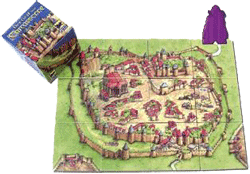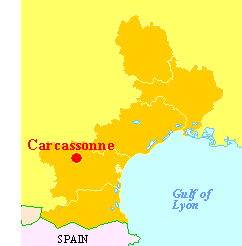
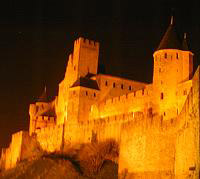
![]() Carcassonne
is a city in the Aude
département of the Languedoc-Roussillon
region in the South of France.
Carcassonne
is a city in the Aude
département of the Languedoc-Roussillon
region in the South of France.
The modern city is build around two medieval cities, the original hill top Cité of Carcassonne on the north side of the river Aude, and the thirteenth century Bastide of Carcassonne on the South side of the River Aude. The older Cité is a spectacular walled town – the largest medieval town in Europe with its city walls intact.
The Cité of Carcassonne is a UNESCO World Heritage site and the setting for many films featuring medieval castles. It is one of the few sights in the world that genuinely justifies the epithet "breath taking". In recent years it has become a major tourist attraction, with all that that entails.
Cité & Château Comtal
The Bastide
Carcassonne History
Carcassonne and the Canal du Midi
Location & Geography
Carcassonne Books & Maps
Carcassonne Myths
Carcassonne Sport
Carcassonne Events & Activities
Carcassonne Economy
UNESCO citation
Carcassonne Trivia
The Cité and the Château Comtal.

![]() The
French word cité does translate as city. It translates
as walled town. This explains why you will find even small
towns like Alet-les-Bains
referred to as cités, and also why the cité
in Carcassonne occupies only a tiny area of the modern city.
The present cité is essentially medieval, although
there are traces of older structures, for example some of
the towers on the inner ring of defensive walls still retain
their distinctive Roman shape and even their Roman foundations.
The
French word cité does translate as city. It translates
as walled town. This explains why you will find even small
towns like Alet-les-Bains
referred to as cités, and also why the cité
in Carcassonne occupies only a tiny area of the modern city.
The present cité is essentially medieval, although
there are traces of older structures, for example some of
the towers on the inner ring of defensive walls still retain
their distinctive Roman shape and even their Roman foundations.

 The
present Cité is recognisable as the medieval one
which was the seat of the Trencavel
family, Viscounts of Carcassonne, before the area was
annexed by France in the thirteenth century. It was besieged
by the French in 1209 soon after the famous massacre at
Béziers,
during the early stages of the wars against the people of
the Languedoc, sometimes known as the Cathar
wars or the Albigensian
Crusade. Click here for more on the Sieges of Carcassonne
in 1209 and 1240.
The
present Cité is recognisable as the medieval one
which was the seat of the Trencavel
family, Viscounts of Carcassonne, before the area was
annexed by France in the thirteenth century. It was besieged
by the French in 1209 soon after the famous massacre at
Béziers,
during the early stages of the wars against the people of
the Languedoc, sometimes known as the Cathar
wars or the Albigensian
Crusade. Click here for more on the Sieges of Carcassonne
in 1209 and 1240.
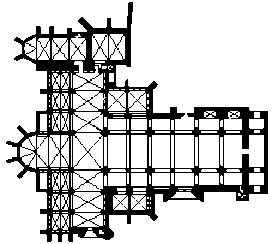
![]() A large part of the structure dates from the pre-French
period, including the inner city walls and part of the Viscounts’
castle known as the chateau Comtal. The outer defensive
walls and the barbican of the chateau Comtal are French,
added in the thirteenth century, and all of it was heavily
restored in the nineteenth century. Before the French period
it was home to the distinctive Occitan
concept of paratge,
as well as to the rich culture of the troubadours
and the Cathars.
A large part of the structure dates from the pre-French
period, including the inner city walls and part of the Viscounts’
castle known as the chateau Comtal. The outer defensive
walls and the barbican of the chateau Comtal are French,
added in the thirteenth century, and all of it was heavily
restored in the nineteenth century. Before the French period
it was home to the distinctive Occitan
concept of paratge,
as well as to the rich culture of the troubadours
and the Cathars.

 The cité was restored from 1853 onwards by the great
architect Eugène Viollet-le-Duc
- narrowly escaping the destruction by Victorian philistines
that befell so many other historic European cities. It was
added to theUNESCO list of World
Heritage Sites in 1997.
The cité was restored from 1853 onwards by the great
architect Eugène Viollet-le-Duc
- narrowly escaping the destruction by Victorian philistines
that befell so many other historic European cities. It was
added to theUNESCO list of World
Heritage Sites in 1997.
Inside the Cité may be found the Basilica of St-Nazaire, once a cathedral (the new cathedral is a much less impressive building in the Bastide of Carcassonne).
Click on this link for more on the Basilica
of Saint-Nazaire 
The Bastide de Saint Louis - La Ville Basse
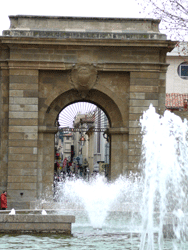
![]()
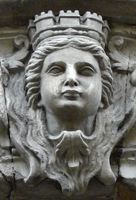
![]()
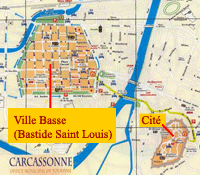
![]() The
French expelled the inhabitants of the original Cité,
not trusting them to help maintain the place against allies
of the dispossessed Trencavel family.
The
French expelled the inhabitants of the original Cité,
not trusting them to help maintain the place against allies
of the dispossessed Trencavel family.
The citizens were permitted to build a new and indefencible town on a plain across the the river Aude. Itwas laid out in the latest fashion in a grid pattern and known as the Bastide de Saint Louis (after King Louis IX of France). Today the bastide has been swallowed by the modern city, but you can still make out the layout of the road grid.
History
|
|

|
|
In 122 BC the Romans invaded the areas that we now know as Provence and Languedoc. Recognising its strategic importance Carcassonne fortified the hilltop around 100 BC and later made it the colonia of Julia Carsaco, later Carcasum. The lower courses of the inner ring of ramparts to the north date from Gallo-Roman times. This Roman settlement was occupied until the mid 5th century AD when it, along with Spain, fell to the Visigoths, invaders originally from the banks of the Danube.
|
The Visigothic king Theodoric II took Carcassonne in 453, and a few years later in 462 the Romans ceded the whole area (Septimania) too. Theodoric built further fortifications at Carcassonne, now a frontier post on the northern marches of his kingdom. Traces of these fortifications still stand. Theodoric, an Arian Christian, is thought to have begun the building of a church now replaced by the basilica in the Cité dedicated to Saint Nazaire. In 508 the Visigoths repelled attacks of the Frankish king Clovis. Moors ("Saracens") from Barcelona took Carcassonne in 725, but the Franks soon returned and in 759. King Peppin the Younger drove most of the Moors away. By 760, Peppin had taken most of what is now the south of France, although he was unable to penetrate Carcassonne. Carcassonne remained under Visigothic rule from 460 to 725. A Visigothic walled city was built in the 5th century by Euric I, King of the Visigoths. In 508 it withstood attack by Frankish king, Clovis I, but fell to the Moors in 725. The Moorish walled city was renamed Carchachouna. |
|
A generation or so later, in 752, the Moors gave way to the Caroligian king, Pépin the Short, who did manage to take Carcassonne, making it a Frankish City. In 1067 Carcassonne became, through marriage, the property of Raymond Bernard Trencavel, viscount of Albi and Nîmes. In the following centuries the Trencavel family allied in succession either with the Counts of Barcelona (later Kings of Aragon) or with the House of Toulouse. They built the Château Comtal and the Basilica of Saint-Nazaire. In 1096 Pope Urban II blessed the foundation stones of the new Catholic cathedral. |
|
|
|
|

![]()

![]() In
1240 Raymond-Roger's son tried to reconquer his inheritance,
but in vain. The city submitted to the rule of kingdom of
France, though there would be more attempted rebellions
into modern times as the local people attempted to return
to their traditional allegence to the Kings
of Aragon, the Trencavels' suzerains. On the left you
can see some of the stones projected into the city by siege
engines (perriers). Some of the projectiles were twenty
times this size - designed to splinter like schrapnel.
In
1240 Raymond-Roger's son tried to reconquer his inheritance,
but in vain. The city submitted to the rule of kingdom of
France, though there would be more attempted rebellions
into modern times as the local people attempted to return
to their traditional allegence to the Kings
of Aragon, the Trencavels' suzerains. On the left you
can see some of the stones projected into the city by siege
engines (perriers). Some of the projectiles were twenty
times this size - designed to splinter like schrapnel.
Click on this link for more on the Carcassonne's
role in the Cathar Wars 
In 1247, King Louis IX of France founded the new part of the town across the river - the Bastide de Saint Louise, now in the heart of the ville basse.
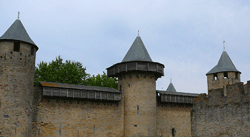
![]()
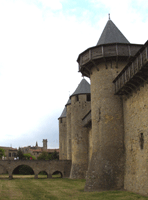
![]()
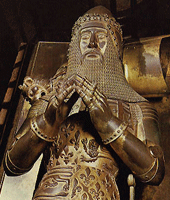
![]() Louis
(Saint Louis) and his successor Philip III built the present
outer ramparts of the old Cité. Opinion at the time
considered the fortress to be impregnable.
Louis
(Saint Louis) and his successor Philip III built the present
outer ramparts of the old Cité. Opinion at the time
considered the fortress to be impregnable.
In 1348 the Black Death struck the Languedoc as it spead across Europe through Italian trade routes. Around 40% of the population died. As in other cities, local Christian leaders invented stories that the disease was caused by infected well water and that wells had been poisoned by Jews. As in Narbonne and other cities, surviving members of the local Jewish community were burned alive for these imaginary crimes.
A few years later the English tested Carcassonne's claim to be impregnable. When Edward the Black Prince attacked Carcassonne in 1355 during the Hundred Years' War, his troops destroyed the Ville Basse without much trouble, but he failed to take the old Cité.
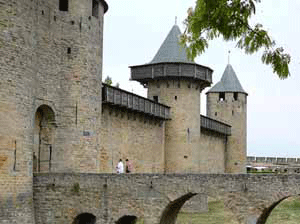
![]()
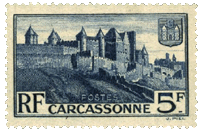
![]() Carcassonne
continued to hold strategic value, now for the French as
a central and second line of defence against the Spanish.
A series of border castles known as the five sons of Carcassonne
(Queribus,
Termes,
Aguila,
Peyrepertuse
and Puilaurens)
provided the first line of defence. In 1659, under the Treaty
of the Pyrenees the Roussillon passed from Aragon to
France. This meant that the Franco-Spanish border shifted
south. The border castles were no longer border castles
and a new set of fortifications were built under de
Vauban. Carcassonne's strategic importance was reduced
and it was allowed to fall into disrepair.
Carcassonne
continued to hold strategic value, now for the French as
a central and second line of defence against the Spanish.
A series of border castles known as the five sons of Carcassonne
(Queribus,
Termes,
Aguila,
Peyrepertuse
and Puilaurens)
provided the first line of defence. In 1659, under the Treaty
of the Pyrenees the Roussillon passed from Aragon to
France. This meant that the Franco-Spanish border shifted
south. The border castles were no longer border castles
and a new set of fortifications were built under de
Vauban. Carcassonne's strategic importance was reduced
and it was allowed to fall into disrepair.

![]() Carcassonne
was removed from the schedule of official fortifications
under Napoleon, and the fortified Cité of Carcassonne
fell into such disrepair that the French government decided
that it should be demolished. An official decree to that
effect that was issued in 1849. It caused an uproar. By
great good fortune the Mayor of Carcassonne, Jean-Pierre
Cros-Mayrevieille, was an antiquary. He and Prosper Mérimée,
the first inspector of ancient monuments in France, led
a campaign to preserve the fortress as a historical monument.
Carcassonne
was removed from the schedule of official fortifications
under Napoleon, and the fortified Cité of Carcassonne
fell into such disrepair that the French government decided
that it should be demolished. An official decree to that
effect that was issued in 1849. It caused an uproar. By
great good fortune the Mayor of Carcassonne, Jean-Pierre
Cros-Mayrevieille, was an antiquary. He and Prosper Mérimée,
the first inspector of ancient monuments in France, led
a campaign to preserve the fortress as a historical monument.

![]()
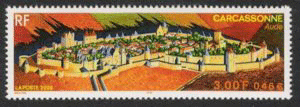
![]() Soon,
the architect Eugène Viollet-le-Duc,
already at work restoring the Basilica
of Saint-Nazaire in the Cité was commissioned
to renovate the whole place. After centuries of neglect
it was heavily restored, and it is this restored
city that makes such an impact today, a World Heritage
site, with plenty of
sites to see and places to visit including
festivals in the City. Fortifications consist of a double
ring of ramparts with 53 towers along the curtain walls.
Soon,
the architect Eugène Viollet-le-Duc,
already at work restoring the Basilica
of Saint-Nazaire in the Cité was commissioned
to renovate the whole place. After centuries of neglect
it was heavily restored, and it is this restored
city that makes such an impact today, a World Heritage
site, with plenty of
sites to see and places to visit including
festivals in the City. Fortifications consist of a double
ring of ramparts with 53 towers along the curtain walls.

![]()

![]() There
is no fee to enter the Cite - this is a working town with
private houses, shops, hotels, and restarants. It also has
an impressive open air theatre inside the city walls.
There
is no fee to enter the Cite - this is a working town with
private houses, shops, hotels, and restarants. It also has
an impressive open air theatre inside the city walls.
The Cité is heavily geared to tourism, so you can expect tourist shops (jewellers, souvenirs, fashion, "Cathar heritage", art, etc) - generally overpriced and indistinguishable from tourist shops pretty much anywhere in the world. It is not its shops that make Carcassonne worth visiting.
|
|
|
|
|
|
Click on the following link for more on Carcassonne
Pre-Roman History ![]()
Click on the following link for more on
Carcassonne Gallo-Roman History ![]()
Click on the following link for more on
Carcassonne Visigothic History ![]()
Click on the following link for more on Carcassonne
Saracen History ![]()
Click on the following link for more on Carcassonne
Frankish History ![]()
Click on the following link for more on Carcassonne
Medieval History ![]()
Click on the following link for more on Carcassonne's
role in the Crusades against the Cathars ![]()
Click on the following link for more on Carcassonne
Restoration ![]()
Click on the following link to visit the Carcassonne
Photo Gallery ![]()
The Canal du Midi
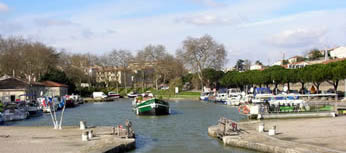
![]() Carcassonne lies on the Canal du Midi, built by Pierre-Paul Riquet a notable Languedoc resident. The Canal is popular for boating holidays and through France's extensive canal network provides a way to get to the Languedoc from the Atlantic Ocean, Northern France and Mediterranean Sea.
Carcassonne lies on the Canal du Midi, built by Pierre-Paul Riquet a notable Languedoc resident. The Canal is popular for boating holidays and through France's extensive canal network provides a way to get to the Languedoc from the Atlantic Ocean, Northern France and Mediterranean Sea.
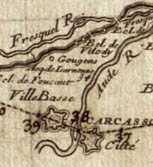
![]() In Riquet's original plans the canal, then called the Royal Canal, passed to the north of Carcassonne using the bed of the River Fresquel. Riquet negotiated with the city fathers to route the canal
through Carcassonne if they would meet the
costs involved. They declined and Riquet was obliged to return to his original plan. So it was that Riquet's canal originally by-passed Carcassonne and followed the river Fresquel. As the canal passed Carcassonne so too the massive increase in trade enjoyed by towns on the canal also passed Carcassonne by. The great military engineer Mareshal de Vauban surveyed the canal and recommended a link to Carcassonne but nothing was to come of it for many years. Eventually a decision was taken to re-route the canal and it was re-engineered to pass along its present route. It opened in 1810, some 150 years after the original canal had been built.
In Riquet's original plans the canal, then called the Royal Canal, passed to the north of Carcassonne using the bed of the River Fresquel. Riquet negotiated with the city fathers to route the canal
through Carcassonne if they would meet the
costs involved. They declined and Riquet was obliged to return to his original plan. So it was that Riquet's canal originally by-passed Carcassonne and followed the river Fresquel. As the canal passed Carcassonne so too the massive increase in trade enjoyed by towns on the canal also passed Carcassonne by. The great military engineer Mareshal de Vauban surveyed the canal and recommended a link to Carcassonne but nothing was to come of it for many years. Eventually a decision was taken to re-route the canal and it was re-engineered to pass along its present route. It opened in 1810, some 150 years after the original canal had been built.
If you are interesed in history, architecture or canals you can spend some enjoyable time tracing the canal's old route to the north of Carcassonne - there is an excellent article on it, with photographs, at http://www.moet-chandon.co.uk/pages/canal-du-midi.php.
Physical and Political Geography
Carcassonneis in the Aude département of which it is the préfecture, in the former Province of Languedoc and the present region of Languedoc-Rousillon. It is located in the between the Black Mountains and the Pyrénées.
It lies on important routes connecting the Atlantic Ocean to the Mediterranean Sea; and Spain to France and Italy. The River Aude flows north from the the Pyrenees ( Pirenèus,
Pirenèus,  Pirineus,
Pirineus,  Pyrénées) to the city and then east into the Gulf of Lyon.
Pyrénées) to the city and then east into the Gulf of Lyon.
The town lies 90 km (56 miles) south-east of Toulouse, just a few kilometers inland from Narbonne.
Carcassonne Books & Maps
Carcassonne Weather
Carcassonne Myths
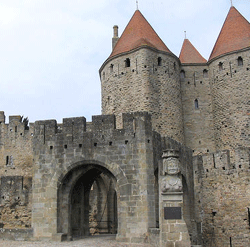
![]()

![]()
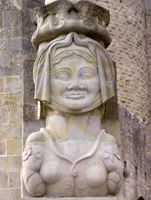
![]() The
folk etymology of the name Carcassonne is endearing and
widely believed. According to the story a châtelaine
of the city, named Carcas, foiled a attempted seige by the
Franks or in some versions the Saracens. At the point of
having to surrender through starvation Carcas found the
last animal alive in the city - a pig - and fed it with
all of the remaining vegetables and offal that remained.
She then threw the well fattened pig over the walls as a present to the
beseigers who, as planned, deduced that the city was well
provisioned and seeing no prospect of the city's surrender,
upped camp and left.
The
folk etymology of the name Carcassonne is endearing and
widely believed. According to the story a châtelaine
of the city, named Carcas, foiled a attempted seige by the
Franks or in some versions the Saracens. At the point of
having to surrender through starvation Carcas found the
last animal alive in the city - a pig - and fed it with
all of the remaining vegetables and offal that remained.
She then threw the well fattened pig over the walls as a present to the
beseigers who, as planned, deduced that the city was well
provisioned and seeing no prospect of the city's surrender,
upped camp and left.

![]()

![]() According
to this apocryphal story the bells rang out in celebration,
giving the city a new name - ("Carcas sona").
A neo-Gothic sculpture of Dame Carcas on a column near the
Narbonne Gate is modern. (Gate shown upper left, detail
upper right), which has led some people to believe that
the story is as modern as the sculpure. In fact the sculpture
is a replacement for a much older one that is now kept inside
the château comtal. Though badly worn it is just about
recognisable (upper far right).
According
to this apocryphal story the bells rang out in celebration,
giving the city a new name - ("Carcas sona").
A neo-Gothic sculpture of Dame Carcas on a column near the
Narbonne Gate is modern. (Gate shown upper left, detail
upper right), which has led some people to believe that
the story is as modern as the sculpure. In fact the sculpture
is a replacement for a much older one that is now kept inside
the château comtal. Though badly worn it is just about
recognisable (upper far right).
Carcassonne Economy
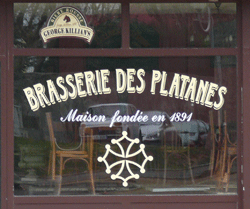
![]()
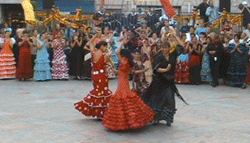
![]() A
major part of Carcassonne's income comes from tourism connected
with the Cité and with other local attractions such
as boat cruises on the Canal
du Midi. Carcassonne receives about three million visitors
each year.
A
major part of Carcassonne's income comes from tourism connected
with the Cité and with other local attractions such
as boat cruises on the Canal
du Midi. Carcassonne receives about three million visitors
each year.
In the late 1990s Carcassonne airport started taking budget flights to and from European airports, and Carcassonne airport (called Salvasa) has grown substancially since then.
Carcassonne lies near to a number of major AOC wine-growing areas in the Languedoc Roussillon.
The newer part of the city around the Ville Basse manufactures shoes, rubber and textiles.
Places to See
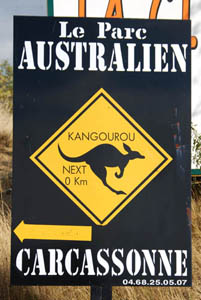
![]() The
City is now a major tourist attraction, and therefore best
avoided in the summer, when it fills up with package tourists
who imagine themselves to be in an early version of Disneyland.
If you like fantasy, you can also visit an Australian Game
Park nearby (see right). The Ville Basse still contains
most of Carcassonne's business activity and is interesting
in its own right. It is also a Medieval cite but was largely
rebuilt in the Seventeenth Century.
The
City is now a major tourist attraction, and therefore best
avoided in the summer, when it fills up with package tourists
who imagine themselves to be in an early version of Disneyland.
If you like fantasy, you can also visit an Australian Game
Park nearby (see right). The Ville Basse still contains
most of Carcassonne's business activity and is interesting
in its own right. It is also a Medieval cite but was largely
rebuilt in the Seventeenth Century.
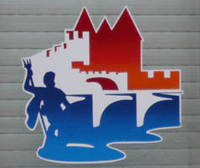

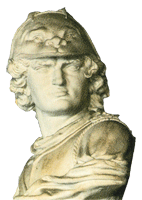
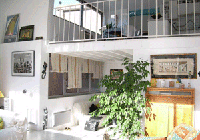

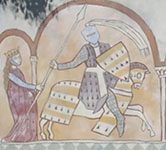








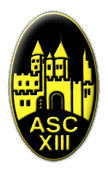

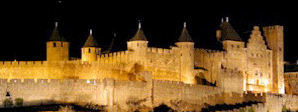 Annual
events & Festivals:
Annual
events & Festivals: 

